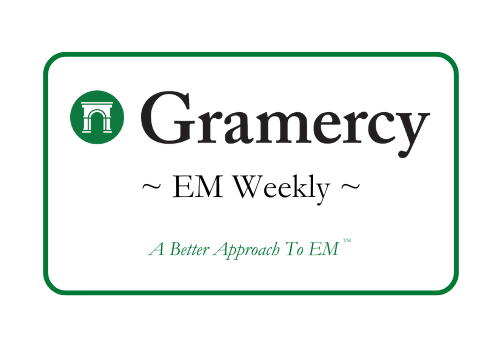Contents
Market Overview
Macro Update
This week delivered one of the most consequential and volatile stretches for global financial markets since the 2008 Global Financial Crisis—marked by record-breaking equity swings, a breakdown in long-held cross-asset correlation, abrupt policy reversals, heightened risk of market malfunction, and rapidly shifting investor sentiment. All of this underscored the uncertainty in the economic and geopolitical landscape.
The week began with a sharp selloff, marking the most significant single-day drop in U.S. stock indexes since the 1987 “Black Monday” crash, as investors grappled with the implications of U.S. President Donald Trump’s “reciprocal tariffs” announcement the previous week.
A rumored 90-day tariff “pause,” dismissed as “fake news” by the Trump Administration on Monday, materialized into policy reality on Wednesday following signs of market dysfunction with equities and bonds selling off in unison. President Trump reversed course and announced this 90-day pause on most tariffs—applicable only to countries that had refrained from retaliating against the U.S. Notably excluded from this reprieve was China, which this week responded forcefully with a matching 125% tariff on U.S. goods and declared “no market acceptance for U.S. goods exported to China.” The broad-based 10% tariff on all U.S. trading partners, a marked escalation from the pre-“Liberation Day” trade regime, remains in effect.
During the tariff-induced confusion, Wall Street firms adjusted their U.S. recession probabilities. J.P. Morgan initially raised its estimate to 60%, while Goldman Sachs increased its forecast to 65%. However, hours later, both firms revised their calls downward to 45% as tariffs were paused. At first, markets celebrated the pause, with the S&P 500 surging 9.5% on Wednesday in the largest daily increase since 2008 and the ninth-best in history. Yet the week concluded on a less upbeat note, as U.S. equity sell-offs resumed amid concerns about medium-term economic damage from tariff uncertainty and the escalating trade war between the U.S. and China.
In this context, this week’s better-than-expected March CPI readings were largely dismissed as “old news.” Headline CPI came in at 2.4% year-over-year and -0.1% month-over-month, vs. consensus expectations of 2.5% and 0.1%, respectively. Core CPI was 2.8% year-over-year and 0.1% month-over-month, against expectations of 3.0% and 0.3%. The minutes from the March 18th-19th FOMC meeting revealed that most policymakers viewed inflation risks as tilted to the upside due to concerns about “persistent” tariff effects, and that they preferred to “wait for more clarity.”
By week’s end, the University of Michigan survey had confirmed a continued plunge in U.S. consumer sentiment, with the preliminary April reading dropping to 50.8 (vs. 53.8 expected) from 57 the previous month. One-year-ahead inflation expectations soared to 6.7%, the highest level since 1981.
Across global macro markets, the gold spot price reached new heights, up 23% year-to-date, amid accelerating safe-haven and inflation-hedge demand. Conversely, crude oil prices continued to plummet, down 16%-17% year-to-date, finishing the week in the low $60s per barrel (Brent), the lowest level since 2021. The U.S. dollar index (DXY) continued its slide, breaking below 100 for the first time in almost two years as investors sought to diversify holdings away from the U.S. EUR/USD approached 1.15, a level last seen in early 2022. The 10-year U.S. Treasury yield rose back to mid-4% levels, after briefly trading below 4.0% the prior week.
Elsewhere, China’s CPI declined 0.1% year-over-year in March, extending deflation for a second month, following a decline of 0.7% year-over-year in February. Amid the escalating trade war with the U.S., concerns about downward pressure on prices are mounting, potentially prompting China’s leadership to consider new stimulus measures.
In the eurozone, February retail sales jumped 2.3% year-over-year vs. the 1.9% expected, but undershot consensus expectations on a month-over-month basis (0.3% vs. 0.5%). Germany’s February industrial production also underperformed market consensus on both year-over-year (-4.0% vs. -3.6%) and month-over-month (-1.3% vs. -1.0%) bases. Final March CPI readings in Germany and Spain were in line with expectations at 2.2% year-over-year and 2.3% year-over-year, respectively. Meanwhile, the Christian Democrats (CDU/CSU) and Social Democrats (SPD) concluded coalition government formation talks, with CDU leader Friedrich Merz likely to be voted in by the Bundestag in early May as Germany’s new chancellor.
UK macro data from the pre-trade war era came in stronger this week. February GDP grew 0.5% month-over-month vs. 0.1% expected, and industrial production outperformed, gaining 1.5% month-over-month, vs. 0.1% consensus, and 0.1% year-over-year, vs. -2.3% consensus.
The reserve banks of India and New Zealand, along with the Central Bank of the Philippines, cut their policy rates by 25 bps to 6.0%, 3.5%, and 5.5%, respectively, as anticipated. Markets were surprised by Kenya’s Central Bank, which lowered the policy rate by 75 bps, vs. 50 bps expected, citing concerns about a weaker global growth outlook.
Softer March CPI readings were observed across major emerging market economies, including Colombia, Indonesia, and Mexico, suggesting increasing room for easier monetary policy. Brazil was an exception, with March headline inflation slightly higher than expected at 5.48% year-over-year, vs. 5.45% expected and 0.56% month-over-month, vs. 0.53% expected.
EM Credit Update
Amid heightened market volatility and ongoing uncertainty, emerging market (EM) fixed income came under broad pressure this week. Hard currency sovereign and corporate bonds declined by 1.87% and 1.70%, respectively, reflecting the combined impact of a global risk-off sentiment and rising core yields. Despite historically being the lowest-beta segment within EM, investment-grade sovereigns led the underperformance, falling 2.34%—a steeper drop than both high-yield sovereigns, which fell 1.41%, and local currency sovereigns, which fell 0.52%. This weakness mirrored a broader sell-off across risk assets and U.S. Treasuries.
Interestingly, despite price declines, EM credit spreads held up relatively well. Sovereign spreads tightened by 5 bps, while corporate spreads widened only modestly by 4 bps, highlighting that the move was largely rate-driven rather than a deterioration in credit fundamentals.
Within the hard currency sovereign space, commodity-linked issuers such as Papua New Guinea, Iraq, and Ecuador underperformed significantly, pressured by falling commodity prices. Conversely, Jamaica, Costa Rica, and Brazil managed to outperform, supported by more resilient macro narratives and technicals.
In the corporate segment, regional dispersion was notable: Africa and Asia lagged, while the Middle East and Latin America delivered relative outperformance. Sector-wise, oil and gas led the losses, followed by metals and mining, with both reflecting commodity price weakness and heightened global growth concerns.
The spike in volatility and uncertainty brought primary market activity to a virtual standstill. No sovereign deals priced during the week, and just six corporate transactions came to market, all of them in Asia.
The Week Ahead
A busy week lies ahead, with a wave of corporate earnings set to provide fresh insight into the health of the U.S. and global economies during the end of the pre-“Liberation Day” environment. Among the most closely watched will be reports from major U.S. banks and consumer staples companies, offering a barometer of both financial system resilience and consumer demand.
On the geopolitical front, high-level talks between Iran and the U.S. are expected to begin in Oman over Tehran’s nuclear program, while EU Finance Ministers, joined by ECB President Christine Lagarde, conclude an informal summit in Warsaw. Elections will also draw global attention: Gabon heads to the polls for presidential and parliamentary races on Saturday, while Ecuador holds a decisive presidential runoff on Sunday between incumbent Daniel Noboa and leftist challenger Luisa González. Meanwhile, Chinese President Xi Jinping is expected to visit Vietnam, Malaysia, and Cambodia in an effort to deepen regional ties, and Italian Prime Minister Giorgia Meloni will meet with President Trump in Washington to discuss tariffs, in coordination with the EU.
A packed macroeconomic calendar includes key data releases such as Japan’s industrial production and CPI, Türkiye’s current account balance, eurozone CPI, the ZEW economic sentiment survey, industrial production, and the ECB’s bank lending survey. Inflation figures are also due from France, Italy, the UK, and Germany. Canada will announce its rate decision, and China will publish a suite of indicators including trade, GDP, property prices, retail sales, and industrial production. In the U.S., markets will be watching for retail sales, industrial production, business inventories, housing starts, weekly jobless claims, and the Philadelphia Fed manufacturing index.
Central bank decisions are expected from the ECB, as well as from monetary authorities in Egypt, South Korea, Türkiye, and Ukraine. On the policy front, Fed Chair Jerome Powell is scheduled to speak at the Economic Club of Chicago, and IMF Managing Director Kristalina Georgieva will speak in Washington ahead of the IMF-World Bank Spring Meetings. The World Trade Organization will release updated global trade forecasts.
Fixed Income
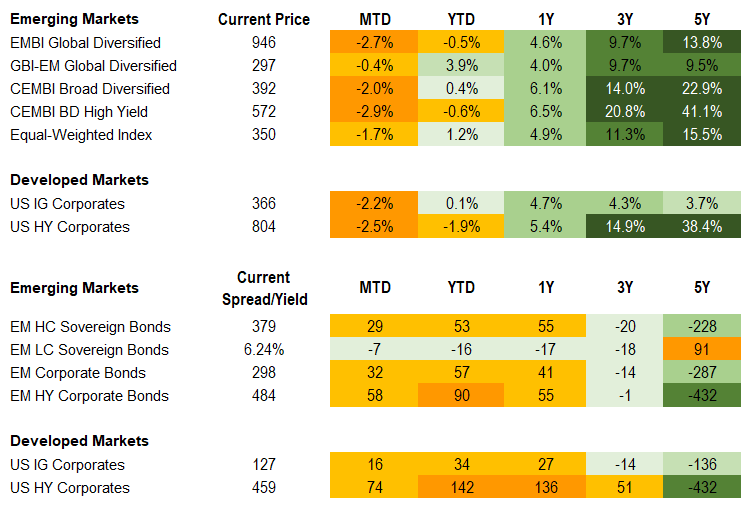
Equities
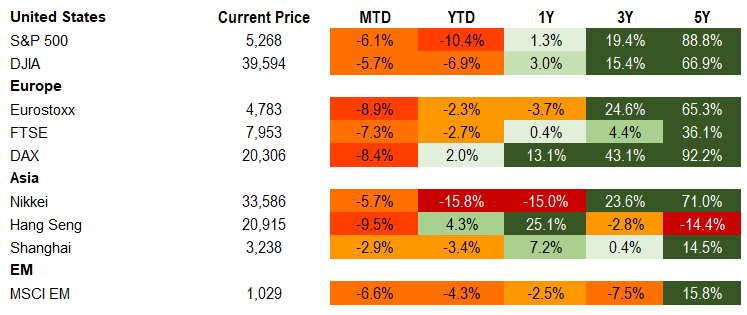
Commodities

Source for data tables: Bloomberg, JPMorgan, Gramercy. EM Fixed Income is represented by the following JPMorgan Indicies: EMBI Global, GBI-EM Global Diversified, CEMBI Broad Diversified and CEMBI Broad High Yield. DM Fixed Income is represented by the JPMorgan JULI Total Return Index and Domestic High Yield Index. Fixed Income, Equity and Commodity data is as of April 11, 2025 (mid-day).
Country Highlights
China-U.S. Trade Escalation and 10% U.S. Global Tariff Threatens Global Growth
Event: In the aftermath of the last week’s initial reciprocal tariff announcements, China and the U.S. continued a tit-for-tat exchange of tariff hikes, bringing the increase in the U.S. tariff on Chinese imports to 145% and the China tariff on U.S. imports to 125%. On Wednesday, President Trump announced a 90-day pause on global reciprocal tariffs ex-China and kept a 10% global baseline tariff in place. Significant market volatility ensued in the aftermath as U.S. equity and treasury markets experienced extreme intraday and intraweek swings. CNY and CNH weakened to 7.34 and 7.42, respectively, before reversing course in the second half of the week. China’s authorities have reiterated willingness to increase domestic stimulus to help offset the significant hit to the external sector from tariffs.
Gramercy Comment: The average U.S. effective tariff remains around 25%, with a lack of clarity over ultimate trade policy goals and destination. This keeps the likelihood of a U.S. recession and global growth slowdown high. While early signs of dysfunction in the U.S. Treasury market may have prompted the 90-day pause, Trump implied a tolerance for negative economic impact later in the week, stating at his cabinet meeting that there will be “transition costs and transition challenges” associated with the new tariffs.
In the case of China, downside growth pressures are mounting, and additional stimulus will be needed to shore up activity. Markets will focus on signals for support and any front-loading of previously announced measures at upcoming meetings, including the Politburo session at month-end. However, authorities may opt to take a patient approach, pushing bigger stimulus to the second half amid some momentum in recent data. China has stated that tariffs above this level are irrelevant and thus, they will no longer respond with further hikes. The country still has a relatively deep economic and financial toolkit to continue with retaliation against the U.S.
Argentina’s Fresh External Financing Is Positive Amid Global Volatility
Event: The IMF announced a staff-level agreement on a comprehensive economic program to support the next phase of Argentina’s reform agenda. This could be supported by a $20 billion, four-year Extended Fund Facility (EFF) that is subject to IMF Board approval, according to the brief IMF press release. The Fund emphasized authorities’ progress in economic stabilization thus far, thanks to a robust fiscal anchor. The new program will aim to increase macroeconomic stability, strengthen external sustainability and drive sustainable growth amid a challenging external environment. Later in the week, Argentina announced renewal of a $5 billion portion of its $18 billion currency swap with China. This comes ahead of U.S. Treasury Secretary Scott Bessent’s visit to Argentina next week where local media has reported a possible discussion of additional financing.
Gramercy Comment: The agreement on a new IMF facility, likely additional funds from other multilaterals, and the renewed portion of the China swap are constructive, particularly amid a more precarious external backdrop. Clarity on the front-loading of the IMF facility and other multilateral funds will be key in determining the additional net cash buffer that will be provided to the authorities this year. Additionally, markets await clarity and execution on the next stage of the reform agenda, notably on foreign exchange and monetary policy. We anticipate some initial adjustment on both in short order, coupled with a staged and gradual loosening of capital controls. If Argentine President Javier Milei maintains a strong mandate in the aftermath of the mid-terms later this year, sustains the macroeconomic adjustment with full lifting of capital controls, regains market access, and resolves ICSID claims, more meaningful FDI flows over the medium term are likely.
Emerging Markets Technicals
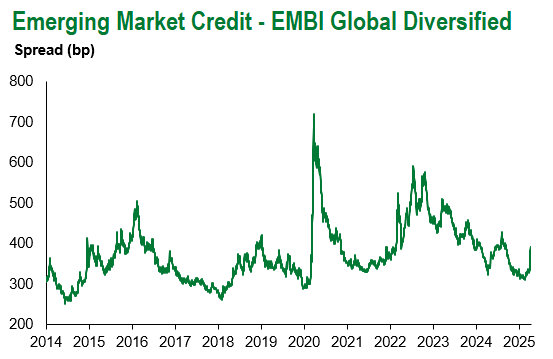

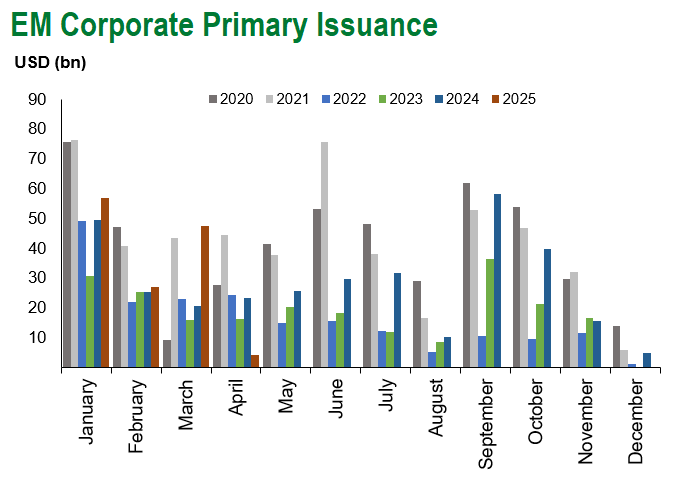
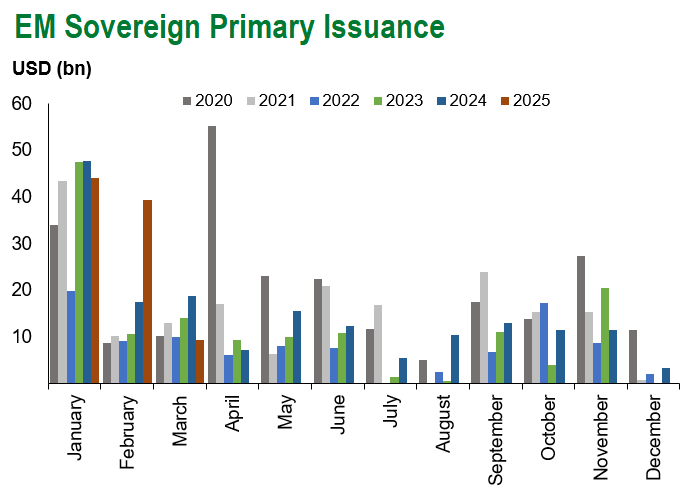
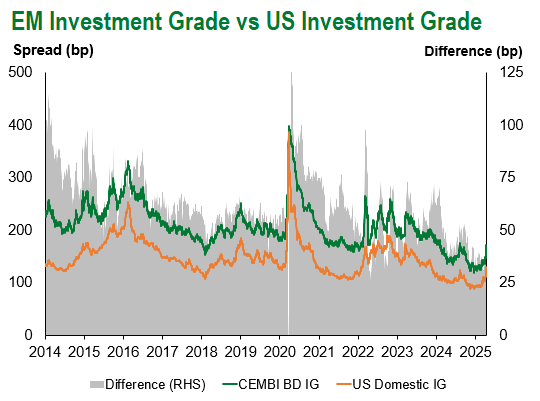
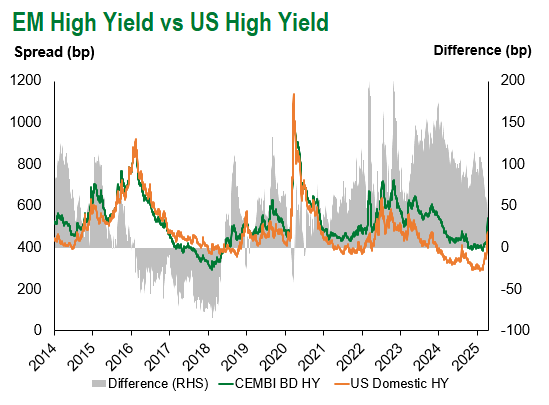
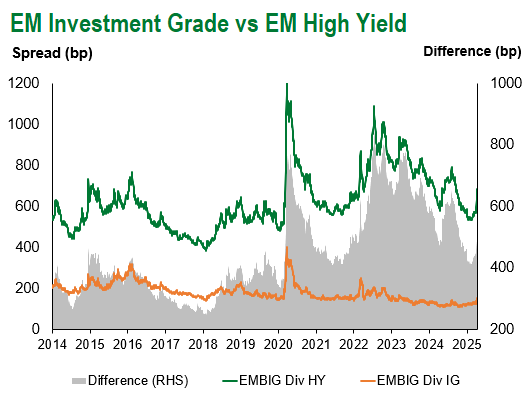
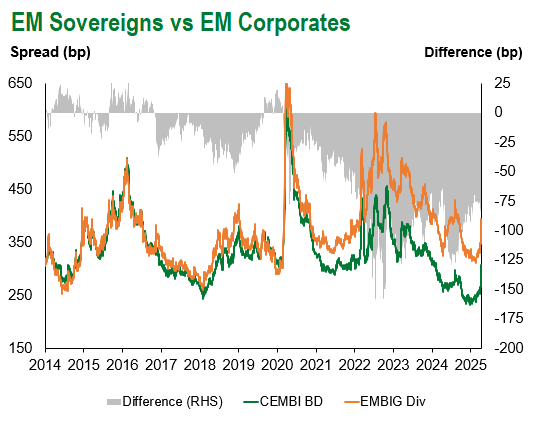
Emerging Markets Flows
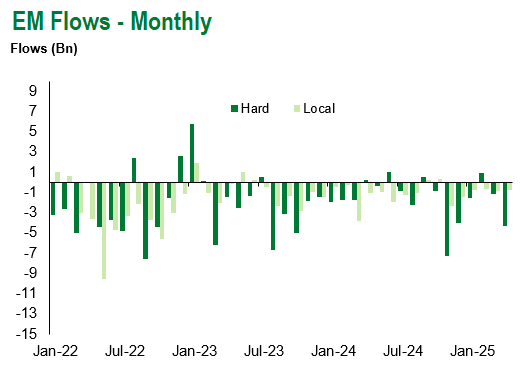
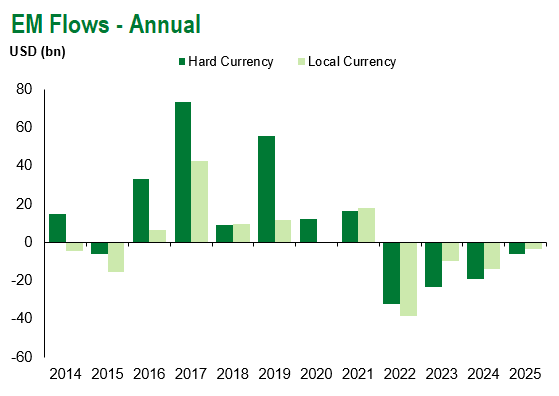
Source for graphs: Bloomberg, JPMorgan, Gramercy. As of April 11, 2025.
For questions, please contact:
Kathryn Exum, CFA ESG, Director, Co-Head of Sovereign Research, [email protected]
Petar Atanasov, Director, Co-Head of Sovereign Research, [email protected]
This document is for informational purposes only. The information presented is not intended to be relied upon as a forecast, research or investment advice, and is not a recommendation, offer or solicitation to buy or sell any securities or to adopt any investment strategy. Gramercy may have current investment positions in the securities or sovereigns mentioned above. The information and opinions contained in this paper are as of the date of initial publication, derived from proprietary and nonproprietary sources deemed by Gramercy to be reliable, are not necessarily all-inclusive and are not guaranteed as to accuracy. This paper may contain “forward-looking” information that is not purely historical in nature. Such information may include, among other things, projections and forecasts. There is no guarantee that any forecasts made will come to pass. Reliance upon information in this paper is at the sole discretion of the reader. You should not rely on this presentation as the basis upon which to make an investment decision. Investment involves risk. There can be no assurance that investment objectives will be achieved. Investors must be prepared to bear the risk of a total loss of their investment. These risks are often heightened for investments in emerging/developing markets or smaller capital markets. International investing involves risks, including risks related to foreign currency, limited liquidity, less government regulation, and the possibility of substantial volatility due to adverse political, economic or other developments. References to any indices are for informational and general comparative purposes only. The performance data of various indices mentioned in this update are updated and released on a periodic basis before finalization. The performance data of various indices presented herein was current as of the date of the presentation. Please refer to data returns of the separate indices if you desire additional or updated information. Indices are unmanaged, and their performance results do not reflect the impact of fees, expenses, or taxes that may be incurred through an investment with Gramercy. Returns for indices assume dividend reinvestment. An investment cannot be made directly in an index. Accordingly, comparing results shown to those of such indices may be of limited use. The information provided herein is neither tax nor legal advice. Investors should speak to their tax professional for specific information regarding their tax situation.
